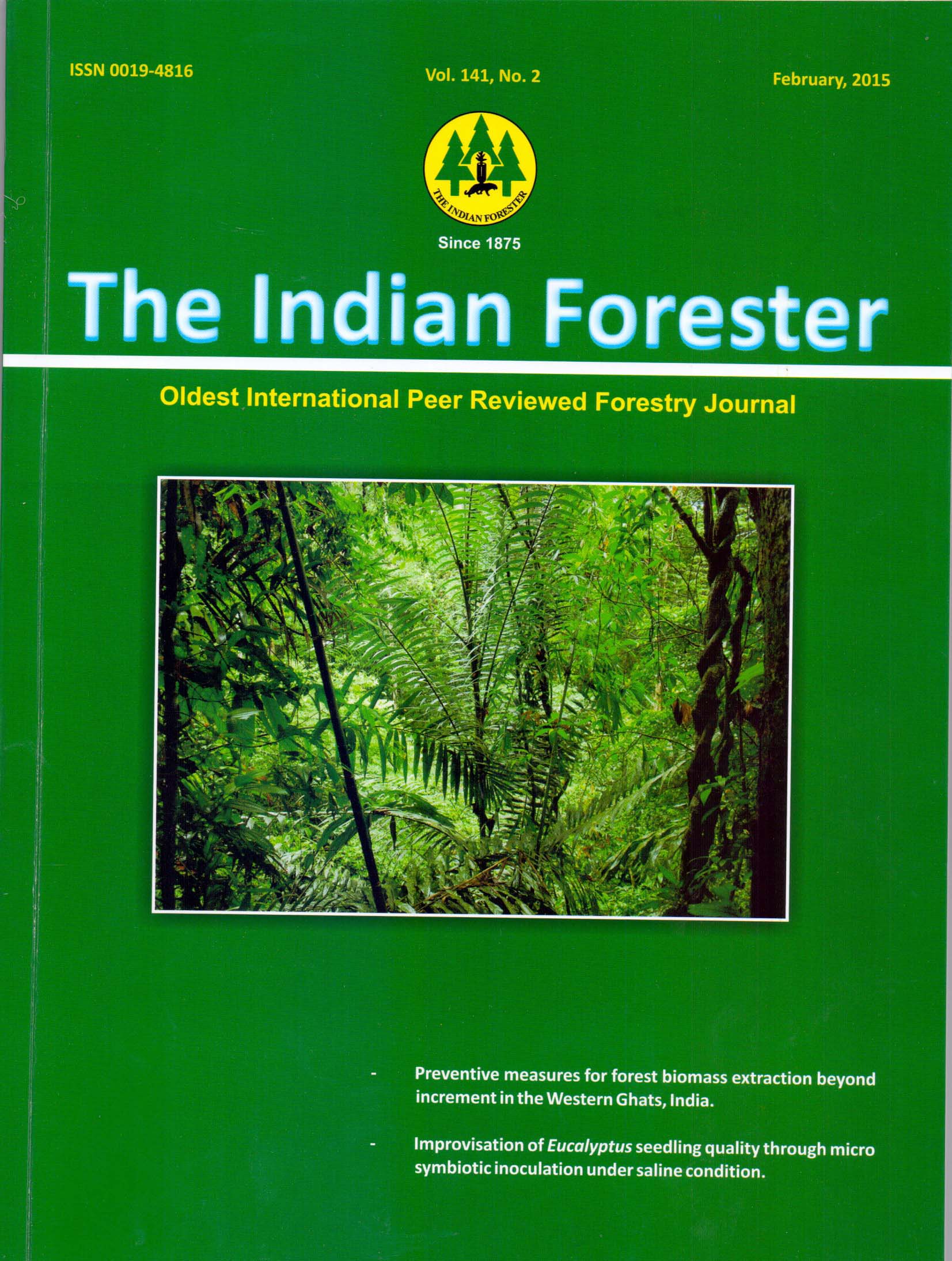Improvisation of Eucalyptus Seedling Quality Through Micro Symbiotic Inoculation Under Saline Condition
DOI:
https://doi.org/10.36808/if/2015/v141i2/60645Keywords:
Microsymbionts, Salinity Levels, Nutrient Content, Chlorophyll Content, Root Colonization, Survival Per Cent.Abstract
Seedlings of Eucalyptus L. were planted under different salinity levels Viz. normal soil (<4 ECe soil), saline soil (4-8 Ece) and highly saline soil (8-12 ECe) and seedlings were inoculated with Azetobactor + vesicular-arbuscular mycorrhizal (VAM) fungi, Azospirillum + vesicular-arbuscular mycorrhizal (VAM) fungi and combination of all three. Experiment repeated for two years and data recorded at the end of each experiment on nutrient content in different plant parts (leaves, stem and root), chlorophyll content, root colonization and survival per cent. Triple inoculation (Azetobactor+Azospirillum+VAM) significantly influenced nutrient status and survival per cent of Eucalyptus seedlings as compared to uninoculated seedlings under salt condition, which was followed by dual inoculation of Azospirillum and VAM.References
Anilkumar K.K. and Kurup M.G. (2003). Effect of Vascular Arbuscular Mycorrhizal fungi inoculation on growth and nutrient uptake of leguminous plants under stress conditions. Journal of Mycology and Plant pathology, 33 (1): 33-36.
Arnon DI (1949). Copper enzymes in isolated chloroplasts:Polyphenoloxidasein Beta vulgaris. Plant Physiol., 24:1-15.
Aseri G.K. and Rao A.V. (2005). Soil biochemical properties and growth of Ber and Aonla as influenced by bio-inoculents. Journal of Indian Society of Soil Science, 53 (3):342-345.
Al-Tahir O.A. and Abdul-Salam M.A. (1997).Growth of Faba beans (Vicia faba L.) as influenced by irrigation water salinity and time of salinization. Agricultural Watermanagement, 34: 161-167.
Corbishley J. and Pearce D. (2007). Growing trees on salt-affected land. ACIAR Impact Assessment Series Report No. 51.
Duarte L., Dillenburg L.R. and Rosa L.M.G. (2002). Assessing the role of light availability in the regeneration of Araucaria angustifolia (Araucariaceae). Aust. J. Bot., 50: 741-751.
Giovanetti M. (1985). Seasonal variation of vesicular arbuscular mycorrhiza and endogonaceous spores in a maritime sand dunes. Transaction of British mycological Society, 84: 679-684.
Jackson M.L. (1967). "Soil Chemical Analysis." Prentice Hall of India Pvt. Ltd., New Delhi.
Marcela C. Pagano, Maria N. Cabello, Antonia F. Bellote, Nadja M. Sa and Maria Ritta Scotti (2008). Intercropping system of tropical leguminous species and Eucalyptus camaldulensis inoculated with rhizobia and mycorrhizal fungi in semi-arid Brazil. Agroforestry system, 74:231-242.
Chaudhary N. (2013). DNA fingerprinting analysis of Eucalyptus species, IOSR Journal of Pharmacy and Biological Sciences, 9(3):7-10.
Srinivasrao C.H, Benzioni A., Eshel A. and Waisel Y. (2004). Effect of salinity on root morphology and nutrient acquisition by faba beans (Vincia faba L.). Journal of the Indian Society of Soil Science, 52 (2): 184-191.
Trivedi B.S., Patel G.G., Desai R.M. and Padhiyar G.M. (1999). Comparison of Kjeldahl's and Chromic acid methods of nitrogen determination. GAU Res. J.,25 (91): 9-14.
Downloads
Downloads
Published
How to Cite
Issue
Section
License
Unless otherwise stated, copyright or similar rights in all materials presented on the site, including graphical images, are owned by Indian Forester.





